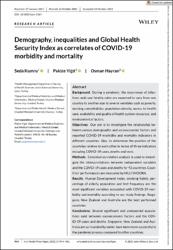| dc.contributor.author | Kumru, Seda | |
| dc.contributor.author | Yiğit, Pakize | |
| dc.contributor.author | Hayran, Osman | |
| dc.date.accessioned | 2022-12-27T08:22:54Z | |
| dc.date.available | 2022-12-27T08:22:54Z | |
| dc.date.issued | 2022 | en_US |
| dc.identifier.citation | Kumru, S., Yiğit, P. ve Hayran, O. (2022). Demography, inequalities and Global Health Security Index as correlates of COVID-19 morbidity and mortality. International Journal of Health Planning and Management, 37(2), 944-962. https://doi.org/10.1002/hpm.3384 | en_US |
| dc.identifier.issn | 0749-6753 | |
| dc.identifier.issn | 1099-1751 | |
| dc.identifier.uri | https://doi.org/10.1002/hpm.3384 | |
| dc.identifier.uri | https://hdl.handle.net/20.500.12511/10190 | |
| dc.description.abstract | Background During a pandemic, the occurrence of infections and case fatality rates are expected to vary from one country to another due to several variables such as poverty, existing comorbidities, population density, access to health care, availability and quality of health system resources, and environmental factors. Objectives Our aim is to investigate the relationship between various demographic and socioeconomic factors and reported COVID-19 morbidity and mortality indicators in different countries. Also, to determine the position of the countries relative to each other in terms of three indicators including COVID-19 cases, deaths and tests. Methods Canonical correlation analysis is used to investigate the intercorrelations between independent variables and the COVID-19 cases and deaths for 92 countries. Countries' performances are measured by MULTIMOORA. Results Human Development Index, smoking habits, percentage of elderly population and test frequency are the most significant variables associated with COVID-19 morbidity and mortality according to our study findings. Singapore, New Zealand and Australia are the best performed countries. Conclusions Several significant and unexpected associations exist between socioeconomic factors and the COVID-19 cases and deaths. Singapore, New Zealand and Australia are surrounded by water, have been more successful in the pandemic process compared to other countries. | en_US |
| dc.language.iso | eng | en_US |
| dc.publisher | Wiley | en_US |
| dc.rights | info:eu-repo/semantics/openAccess | en_US |
| dc.subject | COVID-19 Pandemic | en_US |
| dc.subject | Demography | en_US |
| dc.subject | Health Policy | en_US |
| dc.subject | Socioeconomic Factors | en_US |
| dc.title | Demography, inequalities and Global Health Security Index as correlates of COVID-19 morbidity and mortality | en_US |
| dc.type | article | en_US |
| dc.relation.ispartof | International Journal of Health Planning and Management | en_US |
| dc.department | İstanbul Medipol Üniversitesi, Tıp Fakültesi, Temel Tıp Bilimleri Bölümü, Biyoistatistik ve Tıp Bilişimi Ana Bilim Dalı | en_US |
| dc.department | İstanbul Medipol Üniversitesi, Tıp Fakültesi, Dahili Tıp Bilimleri Bölümü, Halk Sağlığı Ana Bilim Dalı | en_US |
| dc.authorid | 0000-0002-5919-1986 | en_US |
| dc.authorid | 0000-0002-9994-5033 | en_US |
| dc.identifier.volume | 37 | en_US |
| dc.identifier.issue | 2 | en_US |
| dc.identifier.startpage | 944 | en_US |
| dc.identifier.endpage | 962 | en_US |
| dc.relation.publicationcategory | Makale - Uluslararası Hakemli Dergi - Kurum Öğretim Elemanı | en_US |
| dc.identifier.doi | 10.1002/hpm.3384 | en_US |
| dc.institutionauthor | Yiğit, Pakize | |
| dc.institutionauthor | Hayran, Osman | |
| dc.identifier.wosquality | Q3 | en_US |
| dc.identifier.wos | 000717134300001 | en_US |
| dc.identifier.scopus | 2-s2.0-85118841677 | en_US |
| dc.identifier.pmid | 34762746 | en_US |
| dc.identifier.scopusquality | Q2 | en_US |


















